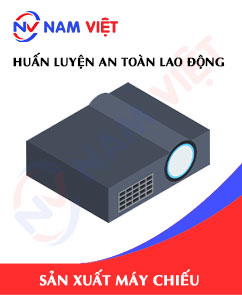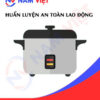Occupational Safety Training For Projector Manufacturing
99,000 ₫
Note: The above price is calculated for one person, the price may fluctuate depending on the number of trainees participating in the course and the movement of the market. For more accurate pricing support, please refer to the quotation or contact directly with our consultants.
Occupational safety is an important issue in projector manufacturing factories and needs to be addressed promptly to ensure the health and safety of workers, as well as to enhance the reputation of enterprises. The Occupational Safety Training course is one of the effective solutions to raise awareness about preventing occupational accidents for workers participating in projector manufacturing.
Table of Contents
Toggle1. Overview of Projectors
a. What is a Projector?
A projector, also known as an image projector, is an electronic device used to project images or videos onto a flat surface such as a screen or a fabric sheet. Projectors are commonly used in meeting rooms, conferences, cinemas, schools, and other entertainment venues.
Projectors can use many image display technologies such as LCD, DLP, or LCOS. Modern projectors often have high resolution and the ability to connect to input devices such as computers, Blu-ray players, or mobile devices.

b. Types of Machinery in Projector Manufacturing
The machinery used in projector manufacturing includes:
- Crystal pellet extruder: The crystal pellet extruder is used to create crystal pellets, a main component for creating LED chips, one of the most important parts of projectors.
- LED chip manufacturing machine: The LED chip manufacturing machine produces LED chips used in LED bulbs to project images onto the screen.
- Component manufacturing machine: Other components such as bulbs, fan systems, and other parts are produced on different specialized machines.
- Assembly machine: The components are assembled on assembly machines to create complete projectors.
- Testing and packaging machine: Testing and packaging machines are used to check product quality before packaging and delivery to customers.

c. Projector Manufacturing Enterprises in Vietnam
Famous projector manufacturing brands worldwide include:
- Epson
- Sony
- Panasonic
- NEC
- BenQ
- Optoma
- ViewSonic
- LG
- Acer
- Dell
- Hitachi
- InFocus
- Canon
- Christie
- Barco
In Vietnam, popular projector brands include: Epson, Sony, Panasonic, NEC, BenQ, Optoma.

d. Specific Jobs in Projector Manufacturing Factories
Group 1
- Chief Executive Officer, Deputy Chief Executive Officer, Department Managers in projector manufacturing factories.
Group 2
- Safety Officers: managing safety in the factory, designing safety procedures, monitoring, and urging employees to comply with safe working procedures.
Group 3
- Procurement of materials and equipment: searching and purchasing necessary materials and equipment for projector manufacturing.
- Manufacturing parts: producing small parts of projectors, including the casing, bulbs, lenses, and electronic components.
- Assembly and testing: assembling small parts into the casing to create a complete product. Then, testing the performance of projectors to ensure product quality.
- Packing and delivery: packing products and transporting them to agents or end customers.
- Maintenance and repair: providing maintenance and repair services for customers, including replacing damaged parts or providing software updates for projectors.
Group 4
- Office work, service, sales, marketing.
- Production planning: quantifying materials, allocating production time, and assigning tasks to employees.
- Product design and development: generating design ideas, creating technical drawings, developing product models, testing feasibility, and product performance.

2. Overview of Occupational Safety Training in Projector Manufacturing
Within the scope of this article, we focus on issues related to group 3, because group 3 is directly involved in the manufacturing process and faces the highest occupational safety risks. Refer to other groups here
a. What is Group 3 Occupational Safety Training?
- Occupational safety training group 3 consists of lessons that provide awareness on how to prevent occupational accidents for employees.
- The occupational safety training course will help employees recognize and avoid hazards, thereby reducing the risks of occupational accidents at work.
REGISTER FOR OCCUPATIONAL SAFETY TRAINING SERVICE
b. Training Duration
Initial occupational safety training duration
- Total training duration is at least 24 hours, including examination time.
- 8 hours of theoretical study on the system of policies and laws on occupational safety and hygiene
- 8 hours of theoretical study on basic knowledge of occupational safety and hygiene
- 4 hours of theoretical study on specialized training content
- 2 hours of practical training on specialized training content
- 2 hours of final theoretical examination at the end of the training course
The safety training center will arrange the time into several training sessions depending on the scheduling of employees. However, typically, there will be 6 training sessions, the course will last 3 days, provided that the manufacturing enterprise can arrange continuous training time.
Periodic occupational safety training duration
- Before the occupational safety card expires, employees who wish to renew must undergo a periodic occupational safety training course, with the periodic training duration being at least 50% of the initial training duration.
Explanation: the total periodic occupational safety training duration is at least 12 hours, including examination time. After completing the periodic training and passing the test, employees will be reissued or have their occupational safety card renewed.
c. Training Content
| No. | TRAINING CONTENT | TRAINING DURATION (HOURS) | |||
| Total | Including | ||||
| Theory | Practice | Examination | |||
| I | System of policies and laws on occupational safety and hygiene | 8 | 8 | 0 | 0 |
| 1 | Overview of the system of legal documents on occupational safety and hygiene. | 6 | 6 | ||
| 2 | System of standards and technical regulations on occupational safety and hygiene. | 1 | 1 | ||
| 3 | Specific regulations of state management agencies on occupational safety and hygiene when constructing new, expanding, or renovating facilities for manufacturing, using, storing, preserving, and inspecting machinery, equipment, materials, and substances requiring strict occupational safety and hygiene. | 1 | 1 | ||
| II | Basic knowledge of occupational safety and hygiene | 8 | 8 | 0 | 0 |
| 1 | Basic knowledge of hazardous and harmful factors in the workplace. | 4 | 4 | ||
| 2 | Methods to improve working conditions. | 1 | 1 | ||
| 3 | Safety culture in manufacturing and business. | 1 | 1 | ||
| 4 | Rights and obligations of employers and employees; policies and regimes on occupational safety and hygiene for employees; functions and tasks of the occupational safety and hygiene network. | 1 | 1 | ||
| 5 | Occupational safety and hygiene regulations, signs, safety instructions, and use of safety equipment, personal protective equipment; operations and skills for first aid in occupational accidents and prevention of occupational diseases. | 1 | 1 | ||
| III | Specialized training content | 6 | 4 | 2 | 0 |
| Comprehensive knowledge of types of machinery, equipment, and substances generating hazardous and harmful factors; analysis, assessment, and risk management of occupational safety and hygiene; safe working procedures with machinery, equipment, and substances requiring strict occupational safety and hygiene. | 6 | 4 | 2 | ||
| IV | Examination of occupational safety training content at the end of the course | 2 | 2 | 0 | 0 |
| Total | 24 | 22 | 2 | ||
See more training content of the 6 groups
d. Occupational Safety Card
After completing the occupational safety training course and passing the examination, employees will be issued an occupational safety card (commonly referred to as a occupational safety certificate group 3).
The group 3 safety card will clearly display information such as: full name, date of birth, job, and specific working environment. It will also include the training duration, a red stamp, and a signature confirming completion of the training course.
According to the regulations on issuing safety cards stated in clause 2 of article 24 of Decree 44/2016/ND-CP, it is divided into two cases:
- If the employer and the employee have a labor contract, the employer must sign, stamp, and seal the safety card for group 3 employees after they have completed the occupational safety training course and passed the examination.
- If the employee is a freelancer, seasonal worker, or does not have a labor contract, the training unit must sign, stamp, and seal the safety card for the employee after they have completed the occupational safety training course and passed the examination.

3. Recognizing Hazards Affecting Workers In Projector Manufacturing
During the projector manufacturing process, employees and workers may face several potential hazards, including:
- Risk of electric shock: Due to the electronic components used in projectors, workers are at risk of electric shock when operating on devices and electrical circuits.
- Risk of fire and explosion: The use of flammable materials such as plastic and electronic components can lead to fire and explosion hazards.
- Occupational safety risks: Machinery and equipment in the projector manufacturing factory can cause occupational accidents such as collisions, cuts to hands or eyes, or hands being trapped.
- Food hygiene and safety risks: During projector manufacturing, workers may use chemicals to clean equipment; if not used properly, they can cause contamination and affect workers’ health.

4. Types Of Occupational Accidents Commonly Occurring To Workers In Projector Manufacturing
The types of occupational accidents that commonly occur to workers in projector manufacturing may include:
- Accidents with machinery and equipment: Workers may be injured or lose their lives when working with machinery and equipment, such as being trapped, entangled, or collided during operation.
- Accidents due to chemical use: Chemicals used in projector manufacturing can cause accidents for workers, such as fire, explosion, burns, or injury from exposure to toxic chemicals.
- Accidents from handling electrical equipment: Workers may be in danger when working with electrical equipment, such as electric shock, fire, explosion, or injury caused by improper electrical devices.
- Accidents from materials and products: In projector manufacturing, workers may be injured due to materials or products that are not handled properly or not transported safely.
- Accidents due to temperature and working environment: Projectors are often manufactured in environments with high temperature and humidity, which may pose risks to workers, such as heat shock or depression.

5. Safety Measures When Participating In Projector Manufacturing
Safety measures when participating in projector manufacturing include:
- Wearing protective equipment: Workers must wear full protective equipment such as helmets, safety glasses, gloves, safety shoes, and protective jackets.
- Using safety devices: Projector manufacturing machinery must be equipped with safety devices such as sensors, safety locks, and emergency stop buttons to minimize accidents during production.
- Training and educating workers: Employees participating in projector manufacturing need to be trained and educated in occupational safety, work processes, risk control, and the use of safety equipment.
- Regular inspection and maintenance of equipment: Projector manufacturing machinery must be regularly inspected and maintained to ensure proper operation and minimize accident risks.
- Monitoring and evaluating safety levels: Managers must monitor and evaluate safety levels during production to detect and resolve occupational safety issues.
- Organizing fire prevention and firefighting drills: Employees in projector manufacturing factories need to be trained in fire prevention and firefighting and participate in drills to be ready to respond to emergencies.
- Implementing regulations on the use of chemicals: Chemicals used in projector manufacturing must be stored and used properly according to manufacturer and state regulations to ensure worker safety.
- Periodically organizing occupational environment monitoring in factories and enterprises, collecting and analyzing harmful factors to workers, thereby adjusting to reduce hazards and prevent occupational diseases for them.
6. Benefits Of Occupational Safety Training In Projector Manufacturing
An Toan Nam Viet provides your business with excellent benefits after completing occupational safety training courses as prescribed in Decree 44/2016/ND – CP on occupational safety and hygiene work, applicable to companies, enterprises, and businesses.
- Workers can identify potential risks of occupational accidents and take preventive measures to avoid accidents.
- Your business establishes risk prevention measures in the production, operation, and maintenance process.
- Minimizing costs when occupational safety risks occur.
- Uninterrupted production helps increase labor productivity and product quality.
- Complying with the law on occupational safety, avoiding legal risks.
- Creating prestige and professionalism in all aspects, thereby elevating the brand for your business.
An Toan Nam Viet’s training courses are solutions to prevent external factors affecting each individual so that they can avoid dangers that may lead to injury or even death.
REGISTER FOR OCCUPATIONAL SAFETY TRAINING SERVICE
7. Customer Feedback After Completing Occupational Safety Training In Projector Manufacturing
An Toan Nam Viet has many years of experience in the mission of accompanying many businesses in Vietnam in general and in southern provinces in particular. That responsibility is extremely valuable to An Toan Nam Viet, so the occupational safety training work of An Toan Nam Viet is always increasingly professional. The motivation for An Toan Nam Viet to grow strong today comes from both positive feedback and suggestions from businesses. Below are feedbacks from partners we have served.
Bac Nam E&C Construction Investment Joint Stock Company
“The first time using the service at An Toan Nam Viet, I was very surprised by the enthusiastic 24/7 support of the consulting team. The class organization was very quick and convenient for our company, thank you very much for An Toan Nam Viet’s service!”
Hoa Dat Construction And Trading Joint Stock Company
“An Toan Nam Viet’s service has helped us a lot in simplifying occupational safety and completing safety records for the work process. The consulting team is enthusiastic and timely in answering our questions. 5 stars for An Toan Nam Viet.”
See more customer interview sessions after using the service of An Toan Nam Viet
8. Capacity Of Occupational Safety Training Of An Toan Nam Viet
An Toan Nam Viet is a reputable and high-quality occupational safety training center in Vietnam today. With occupational safety training sessions continuously held at manufacturing workshops, factories, or construction sites across the country (63 provinces and cities in Vietnam).
REGISTER FOR OCCUPATIONAL SAFETY TRAINING SERVICE
License for occupational safety training
- An Toan Nam Viet has been inspected and granted a certificate of eligibility for occupational safety and hygiene training by the Occupational Safety Department of the Ministry of Labor – Invalids and Social Affairs. This further strengthens our capacity in occupational safety training activities.

Documents and lectures
- Before occupational safety training documents are used in occupational safety training courses, they are reviewed and approved to ensure that the lectures are always accurate in knowledge and effective in application.
- The teaching methods of lecturers are standardized according to An Toan Nam Viet teaching standards, a method researched and summarized by experts in occupational safety and hygiene training to bring the highest knowledge absorption efficiency to learners.
Facilities
- Controlling factors in classrooms affecting the training process increases teaching efficiency and learners’ knowledge absorption.
- Facilities supporting training courses of ours always arrange spacious classrooms meeting standards in area, lighting, training equipment, etc.
9. Prestigious High-Quality Occupational Safety Training Center Nationwide
At An Toan Nam Viet, we always put our professional dedication to occupational safety training as the top priority. For us, imparting knowledge of self-protection to workers so that they have safe baggage on their livelihood journey is contributing to building the country.
To ensure effective training, we carefully and meticulously prepare every detail, no matter how small. From preparing tools, teaching equipment to curricula, documents, sound, and lighting.
Our occupational safety training lecturers are experts with many years of experience in the field. They even have research projects on identifying hazards in all professions and how to prevent them.
Lectures are drawn from practice and delivered vividly and understandably to workers. These factors help workers feel comfortable during study time and absorb our teaching knowledge well. Of course, the knowledge delivered always follows Decree 44/2016/ND-CP.
From there, workers grasp many preventive measures against hazards and ways to protect themselves. At the same time, they apply them appropriately in actual work.
Our safety training center is proud to provide reputable, professional occupational safety training services with the following advantages:
- Competitive training costs but guaranteed training quality.
- Flexible training schedules suitable for the company’s production situation.
- Quick occupational safety training certification procedures in accordance with the law.
- Training lecturers with many years of experience in the profession.
- Classrooms with controlled factors affecting the training process to increase teaching efficiency and learners’ knowledge absorption.
- Lectures compiled in accordance with occupational safety work at enterprises.
- An Toan Nam Viet works dedicatedly and professionally to support customers accurately and quickly.

10. Additional References For Occupational Safety Training In Projector Manufacturing
- Occupational safety training document set
- Occupational safety documents in projector manufacturing
- Occupational safety training test set
- Projector manufacturing occupational safety training curriculum
- Multiple-choice test on occupational safety in projector manufacturing
1 review for Occupational Safety Training For Projector Manufacturing
No comments yet















namchinh.haiphong341
Dịch vụ huấn luyện an toàn lao động rất tốt nhé!